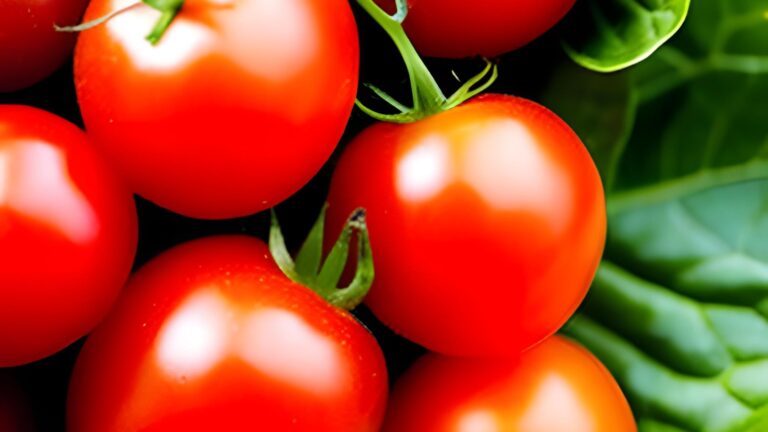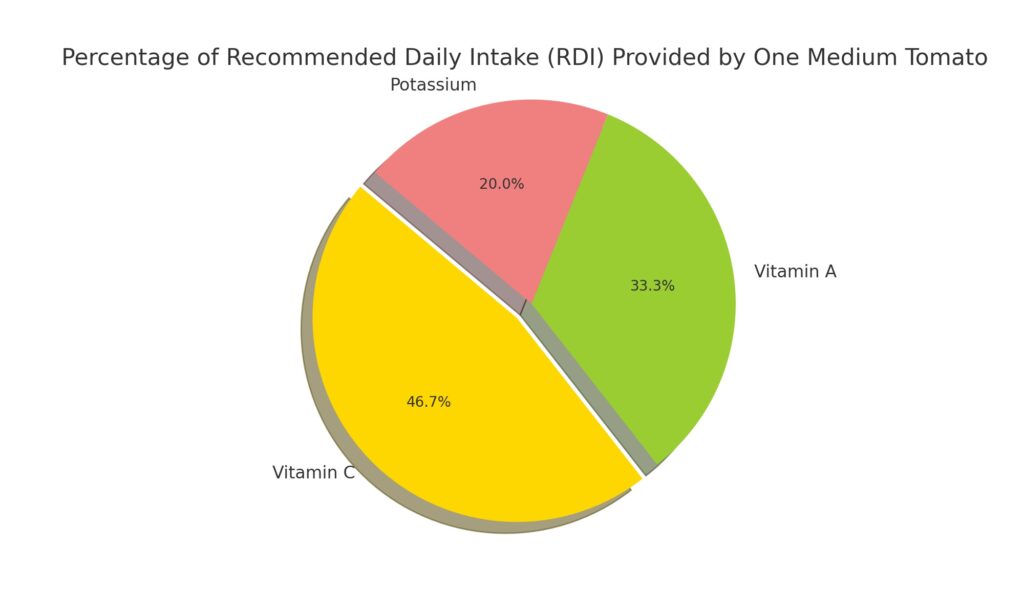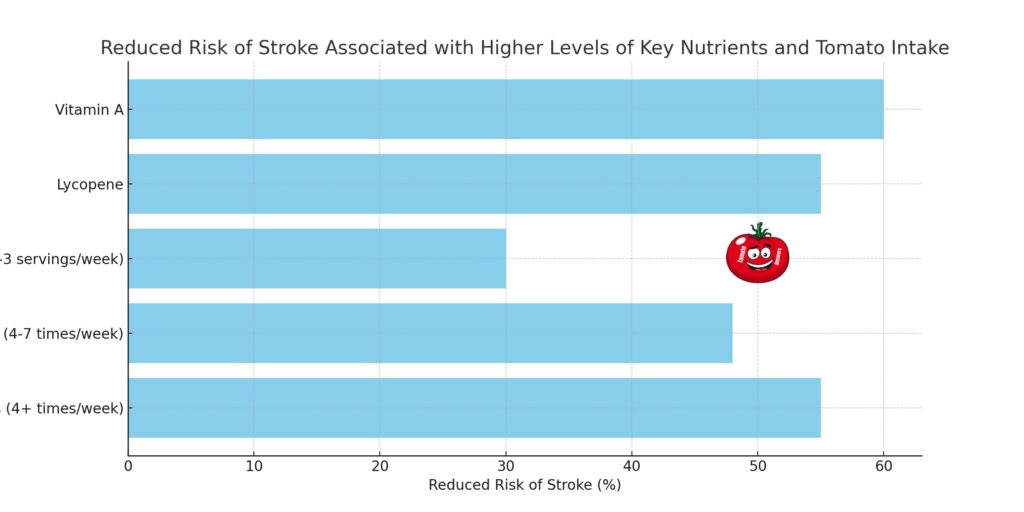According to multiple studies, eating tomatoes regularly can significantly reduce your stroke risk. Tomatoes contain beneficial nutrients and compounds that protect against stroke.
In This Article
The Powerful Nutrients in Tomatoes for Stroke Prevention
Tomatoes contain key nutrients like vitamins C, A, and potassium, which are important for heart health. These nutrients have antioxidant and anti-inflammatory properties to help prevent damage to blood vessels in the brain.
Vitamin C
Tomatoes are an excellent source of vitamin C. One medium tomato provides about 28% of the recommended daily vitamin C intake.
Vitamin C is a powerful antioxidant that protects cells from oxidative damage caused by free radicals. Oxidative damage contributes to atherosclerosis, a disease in which plaque builds up in the arteries.
Atherosclerosis in the carotid arteries supplying blood to the brain is a significant risk factor for ischemic stroke. Vitamin C helps prevent plaque buildup and keeps arteries flexible.
Multiple studies show that people with higher vitamin C intake from their diet have a reduced risk of stroke.
Vitamin A
Tomatoes also contain valuable vitamin A, with one tomato providing about 20% of the recommended daily intake.
Vitamin A is essential for immune function and has antioxidant properties. It helps control inflammation in blood vessels that can lead to clot formation and atherosclerosis.
A study in the journal Neurology found that people with the highest blood levels of vitamin A had a 60% lower stroke risk than those with the lowest levels.
Potassium
One medium tomato can also provide about 12% of the RDI for potassium. This mineral helps control blood pressure as it counters the effects of sodium.
High blood pressure is the single most important modifiable risk factor for stroke. Potassium helps relax blood vessel walls and lower blood pressure.
A high intake of potassium-rich fruits and vegetables like tomatoes is associated with a significantly reduced risk of stroke, according to this meta-analysis study.
The Antioxidant Lycopene in Tomatoes
In addition to vitamins C, A, and potassium, tomatoes are one of the primary dietary sources of the antioxidant carotenoid called lycopene.
Lycopene gives tomatoes their reddish color. It is a powerful antioxidant that protects LDL cholesterol from becoming oxidized.
Oxidized LDL cholesterol sticks to the walls of arteries and causes blockages. Research shows that people with the highest blood levels of lycopene have a 55% lower risk of stroke.
In one study, women with the highest lycopene intake had a 50% lower stroke rate than those with the lowest intake.
How Much Tomato Intake Is Ideal for Stroke Prevention?
To get protective benefits against stroke, it’s ideal to eat tomatoes regularly as part of a healthy diet.
Several studies have found significant reductions in stroke risk with higher tomato intake:
- Eating 2-3 servings of tomatoes weekly was associated with a 30% lower stroke risk in men per this study.
- According to this research, women eating tomatoes 4-7 times a week showed a 32-48% reduced risk for total stroke.
- One study found that adults eating tomatoes 4 times or more per week had a 55% lower hemorrhagic stroke rate than those eating tomatoes less than once a week.
Based on this data, eating tomatoes 4 or more times per week protects against stroke significantly. Include tomatoes in salads, soups, stews, sandwiches, salsa, pasta sauce, and other dishes.
Protection From Stroke Even With Cooked Tomatoes
Notably, the beneficial effects are seen from raw and cooked tomatoes. While lycopene is more bioavailable from cooked, processed tomatoes, vitamin C is higher in fresh raw tomatoes.
So enjoy tomatoes in all forms – raw, stewed, sauced, juiced, etc. Canned and sundried tomatoes also retain nutrients and provide benefits for stroke prevention.
Other Healthy Foods That Reduce Stroke Risk
While tomatoes have proven anti-stroke benefits, they are most effective in a healthy diet. Here are some other foods and drinks that lower stroke risk:
- Leafy green vegetables like spinach and kale provide carotenoids, folate, and vitamin K for protecting arteries.
- Walnuts and fatty fish like salmon contain omega-3 fatty acids that reduce inflammation and blood clotting.
- Berries are rich in anthocyanins and polyphenols that improve blood pressure and arterial function.
- Tea contains polyphenols that reduce LDL oxidation and help blood vessels dilate properly.
- Whole grains provide fiber, B vitamins, and minerals to decrease atherosclerotic plaque buildup.
- Beans and lentils improve blood cholesterol and lower blood pressure due to fiber, potassium, and folate.
- Moderate alcohol, like red wine, may increase good HDL cholesterol and prevent clots.
Along with these foods, limiting salt, added sugars and saturated fats is essential for keeping blood vessels healthy and reducing stroke risk.
The Bottom Line
Research indicates that eating tomatoes 4 or more times per week can decrease stroke risk by 50% or more. The nutrients and antioxidants in tomatoes, including vitamins C, A, potassium, and lycopene, provide this beneficial impact.
Enjoy tomatoes as part of a diet focused on vegetables, fruits, whole grains, nuts, fish, and healthy oils. This comprehensive approach offers the best protection against stroke and other cardiovascular diseases.
Frequently Asked Questions
Q: How do tomatoes help prevent stroke?
A: Tomatoes contain antioxidants like lycopene and critical nutrients such as vitamin C, A, and potassium that protect blood vessels from damage and lower stroke risk factors like high blood pressure.
Q: What are the warning signs of a stroke?
A: Sudden numbness on one side, confusion, trouble speaking, vision problems, dizziness, and severe headache are signs of a potential stroke. Call 911 immediately if you notice these.
Q: Does cooking tomatoes reduce their benefits?
A: No, cooked and processed tomatoes, including sauces, juices, and soups, retain their protective nutrients and lycopene. Enjoy tomatoes in any form.
Q: What other lifestyle factors can help prevent stroke?
A: Quitting smoking, being physically active, limiting alcohol intake, and managing conditions like high BP and diabetes are fundamental lifestyle changes to reduce stroke risk.
Q: Are cherry tomatoes as beneficial as regular tomatoes?
A: Cherry and grape tomatoes contain the same protective nutrients and antioxidants. Enjoy them as a snack or salad topper.
Q: Can tomato juice provide the same benefits?
A: Yes, tomato juice retains the critical nutrients in tomatoes and is shown in studies to reduce blood pressure and stroke risk.
Q: How else can I boost antioxidant intake to lower stroke risk?
A: Berries, walnuts, tea, beans, whole grains, spinach, and fatty fish are excellent sources of antioxidants for stroke prevention.
Q: Does lycopene have other health benefits?
A: Yes, lycopene may help reduce the risk of cancer, heart disease, macular degeneration, bone loss, and type 2 diabetes.
Q: Are tomatoes safe to eat for people on blood thinners?
A: Yes, tomatoes are safe on warfarin and do not interact. They provide vitamin K but not enough to affect INR levels.



